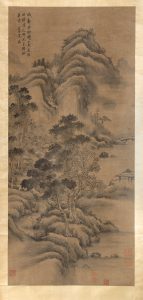LUX ORIENTALIS. Oriental Art Works from the Lithuanian Art Museum Collection. Exhibition
2 February–6 May 2017

The Lithuanian Art Museum’s collection of Oriental art started being assembled back during the years of the Second World War. The first coloured woodblock prints by Japanese artists were acquired from the engineer and architect, Algirdas Mošinskis (1905–1991), a collector of art, old books and maps. The collection of the Vilnius Bernardines added to the museum’s holdings with their contribution of traditional Chinese landscape scrolls and calligraphy paintings. These pieces have come from the long-standing editor of Aidai, poet and Oriental art specialist, Fr. Leonardas Andriekus (from the Order of Friars Minor) (1914–2003), as well as donations from the Australian Lithuanian community’s public figure Genovaitė Kazokienė (1924–2015) and the family of the Lithuanian émigré arts patron and philanthropist who settled in the United States, Leonas Maskoliūnas.
On display in this exhibition are unique examples of early traditional Oriental painting. The famous Ming Dynasty Chinese artist, Shen Zhou (1427–1509), author of Mountain Landscape, perfected landscape scroll painting, as well as being known for his calligraphy and poetry, and had a strong impact on future generations of Chinese artists. The Chinese artist Yun Shouping (1633–1690) – an art authority and intellectual from the Qing Dynasty – was a traditionalist who mastered the Song and Yuan landscape painting traditions, created high floral and bird genre art works, becoming the founder of the Ch’ang-chou school of painting and thus widely popular across all of China. The painting Bamboo by talented Japanese artist Kano Tanyū (1602–1674), the successor of the Kano dynasty of painters, also takes a special place in this exhibition. Painting using the sumi-e or suibokuga technique (subtle painting in ink on rice paper or silk), this multi-talented representative of the Kano school became the official artist of the shogunate. In his work, he upheld the monochromatic painting tradition, using minimal materials to create a meditative and spell-binding landscape.
The origins of Japanese woodblock prints. closely related to Buddhist ritual texts and their spread, lie in the art traditions of neighbouring China and Korea. The carvings were understood as a unique synthesis of three different arts – drawing, painting and calligraphy. It is said that the artistic language of these carvings is close to that of poetry, while their compositional structure echoes Japanese theatre. The Japanese masters sought to reflect and highlight the unity of man and his surroundings, the living and non-living worlds, and the harmony in the war between contradictions in nature. Here at the exhibition, visitors will see distinctive early Japanese ukiyo-e coloured woodblock prints created in the 17th–19th centuries. This stylistic mode (ukiyo-e may be taken as the art of the constantly changing world, or the poetry of everyday life) reflected city dwellers’ tastes and their daily aesthetics. Prints were used to decorate home interiors, books and calendars. Often, the artistic prints functioned as modern fashion magazines, advertising trendy textile patterns and kimono designs. The art works would depict crowded city streets, various festivals, colourful forms of entertainment, no and kibuki theatre actors, wrestlers, courtesan neighbourhoods, beautiful geishas and poetic natural landscapes. This aesthetic sensibility was especially developed by Yoboku Tsunenobu (1636–1743) in his portrayal of the kind goddess, protector of children, Bosatsu. The golden age of Japanese graphic art is also reflected in the works of other famous ukiyo-e masters: the images of daily city life from the Annals of the Green Houses (1804) of Kitagawa Utamaro (1753–1806), the illustration by Kitao Masanobu (1761–1816) from The Book of Jokes (ca 1810), Ando Hiroshige’s (1797–1858) Fish, Shells and a Peach Tree Twig (1833) with the hokku three-liner: “Washed by waves, polished by rocks, the shell nurtures its beautiful pearl”, and the print by Utagawa Kuniyoshi (1797–1861) Woman on the Verandah (ca 1840). The aristocratic Japanese art tradition is seen in the works of Yama Kanasagi, who created floral and bird compositions on rice paper, and Watanabe Kadzan’s (1793–1841) carving of an ancient pine. Japanese woodblock carvings developed into an independent art phenomenon only towards the late 17th century, while Europe first taste of this art form was at the world expos in 1862–1883 held in London and Paris. This acquaintance propelled not only its revival in Europe, but also had a lasting impact on European art aesthetics from the second half of the 19th century, especially visible in Art Nouveau and Impressionism.
Ilona Mažeikienė
4 Didžioji st, Vilnius, Lithuania
+370 5 261 1685
vpg@lndm.lt













